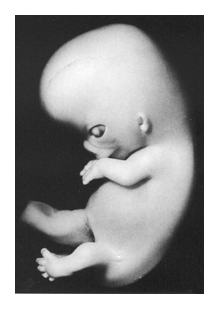The Stages of Human Embryonic Development
Stage 22 embryos have a greatest length of 23.4 to 27.5 mm and an estimated postfertilization age of 52 to 55 days. At this stage the eyelids cover approximately half of the exposed part of the eye. The fingers approach those on the other side and sometimes touch and overlap. Laminations in the tectum of the mesencephalon represent the presumptive superior colliculi. Many nuclei, fiber tracts and commissures are evident in the brain. The cochlear duct has formed a complete circle with the tip upturned for the second time. The palatine shelves have moved to the horizontal position above the tongue and make contact with the lower edge of the nasal septum. A lumen is present in a portion of the submandibular duct. All of the vertebral segments have formed and exhibit normal spina bifida. All of the joints of the extremities can be identified. Ossification has begun in the clavicle and long bones. A few large glomeruli are present in the kidney and the paramesonephric ducts fuse with each other near the dorsal side of the bladder trigone.
| Browse the section images |
| 3D reconstructions |
| More info ... |
